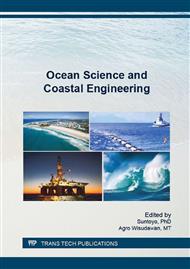p.189
p.197
p.202
p.208
p.214
p.220
p.226
p.232
p.238
Identifying Characteristics of Accidents in Japan's Five Major Ports
Abstract:
The objective of this study is to identify various characteristics of accidents in Japan’s five major ports and to correlate the design and construction factors of these ports with accidents to better predict the occurrence of accidents based on port design and construction. The five major ports in Japan include the ports of Tokyo, Yokohama, Nagoya, Kobe, and Osaka as determined by their foreign container volumes. Data from the Japan-Marine Accident Risk and Safety Information System (J-MARISIS) is analyzed using the 4M Overturned Pyramid (MOP) model. The MOP model is a 3-dimensional model appearing as a three-sided inverted pyramid, consisting of 4 corners that represent the 4M factors (man, machine, media, and management) with the man factor always located at the bottom. The data analysis revealed that each port has its highest causative factor, but the highest causative factor for accidents in Japan’s five big ports is the man factor, followed by the management factor, media factor, and machine factor, in that order. The highest causative factor is also affected by the man-machine relationship. A correlation between port design or construction and marine accidents is not identified using the current MOP Model method, although design is accounted for in the machine factor.
Info:
Periodical:
Pages:
214-219
Citation:
Online since:
January 2017
Keywords:
Price:
Сopyright:
© 2017 Trans Tech Publications Ltd. All Rights Reserved
Share:
Citation:


